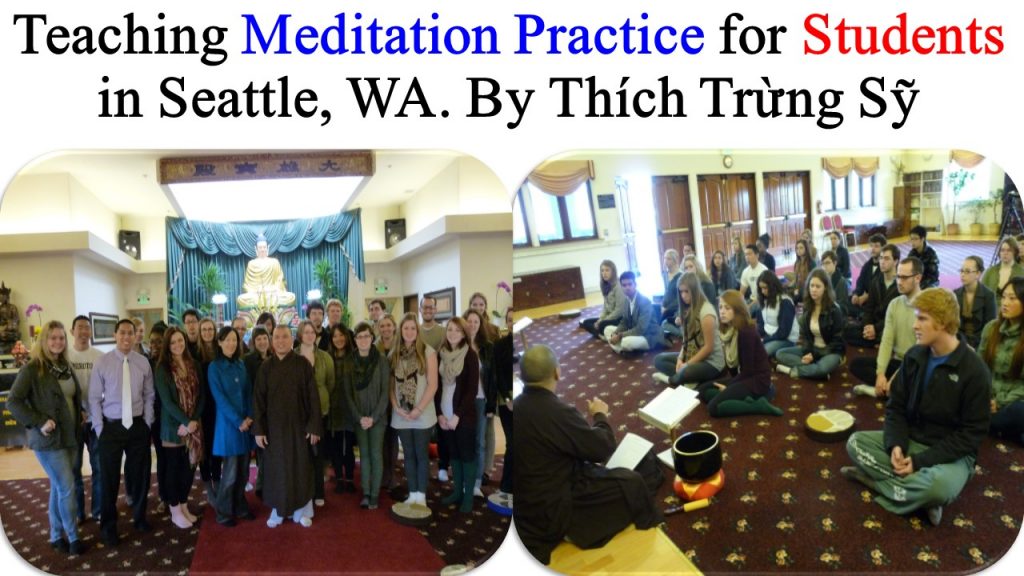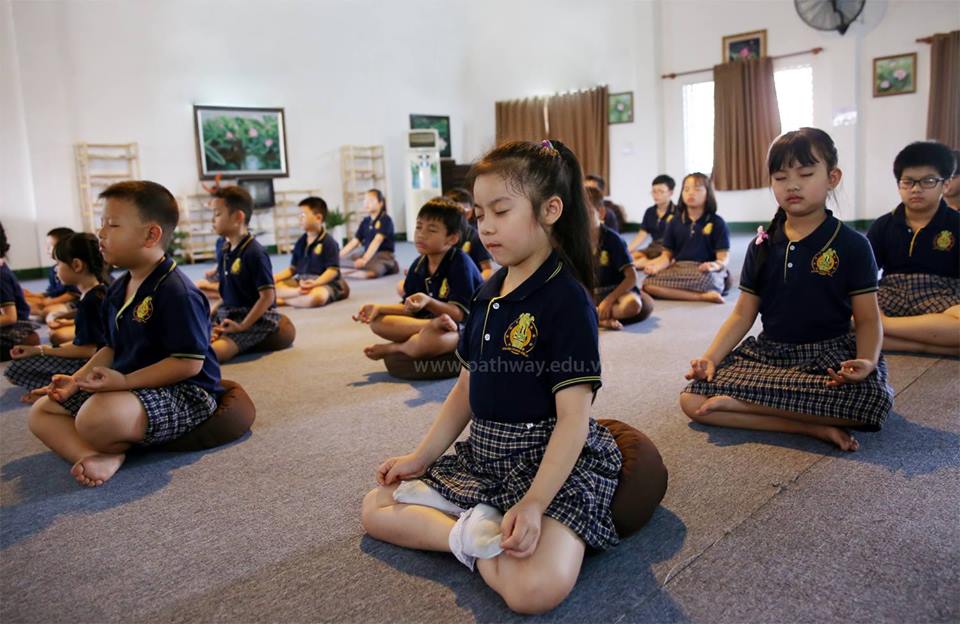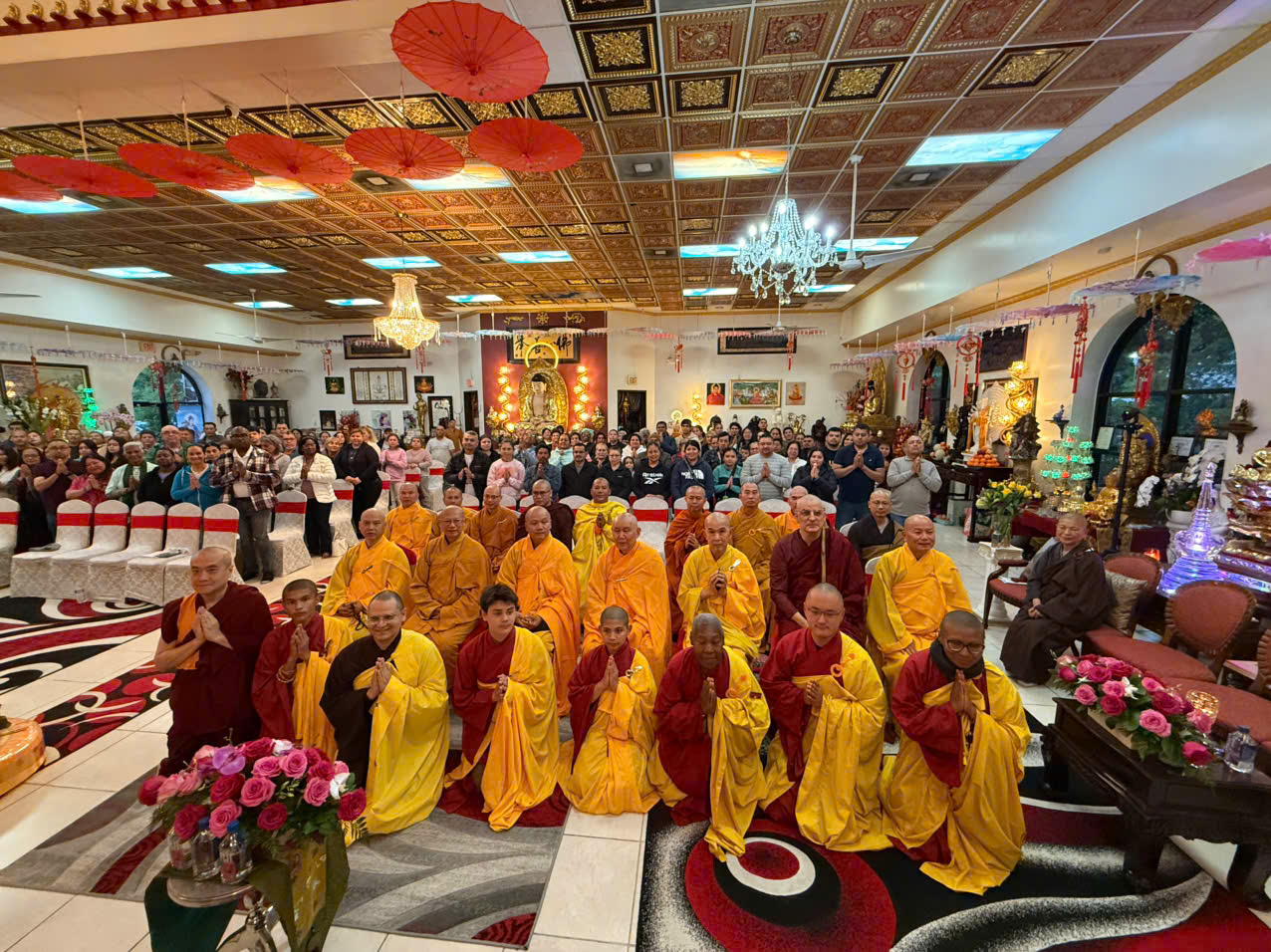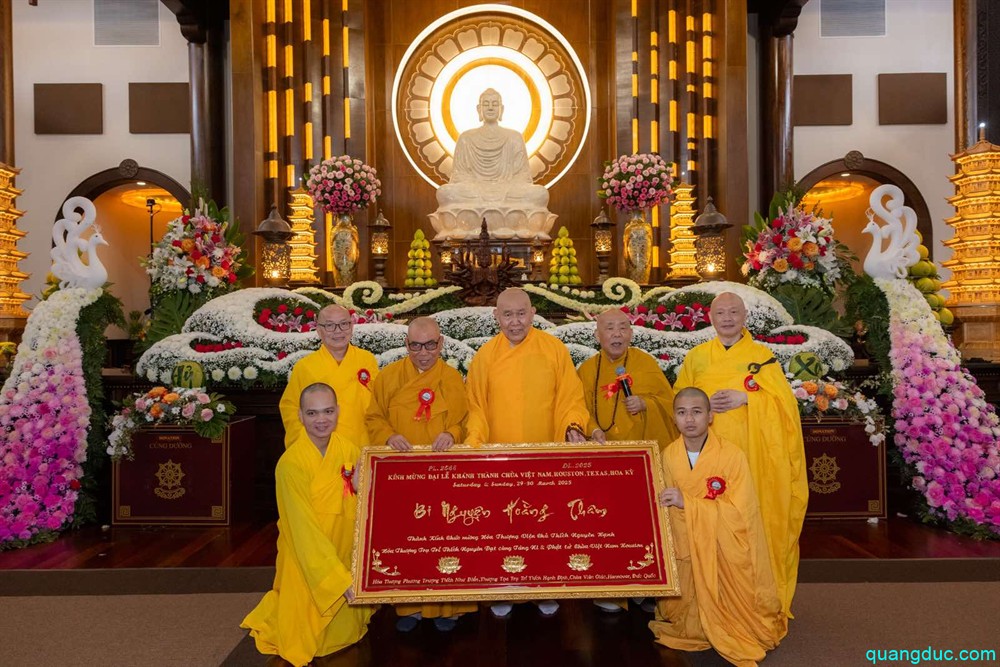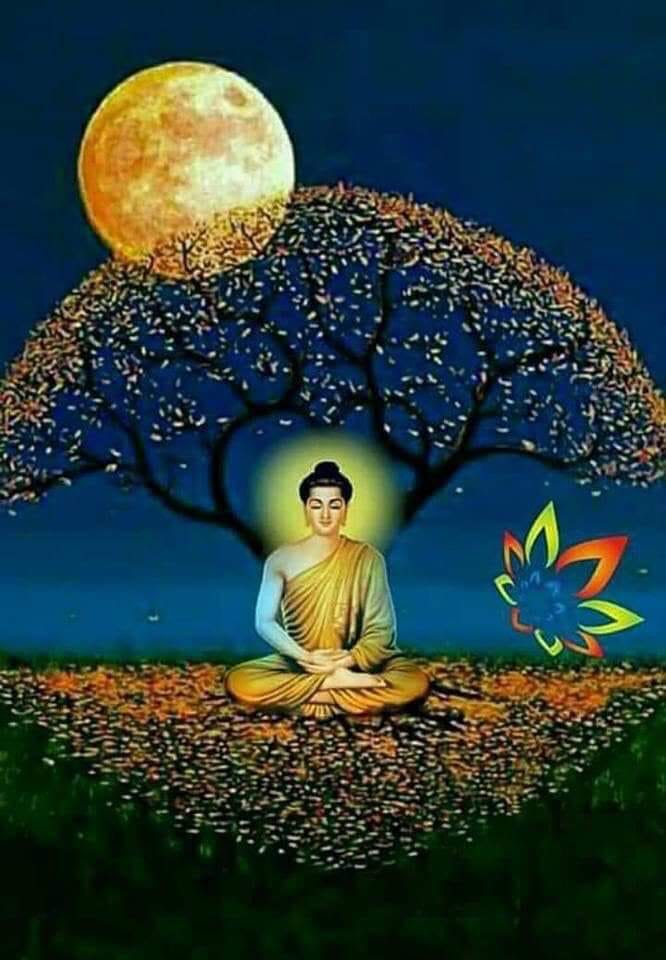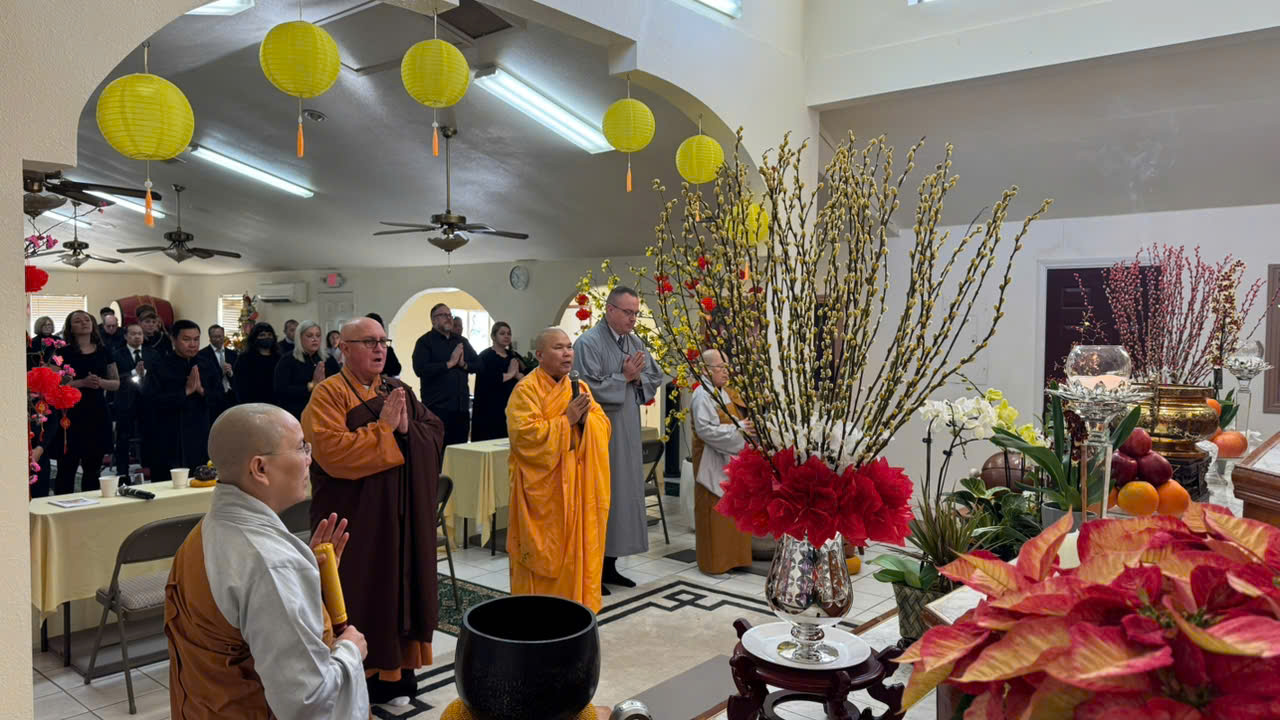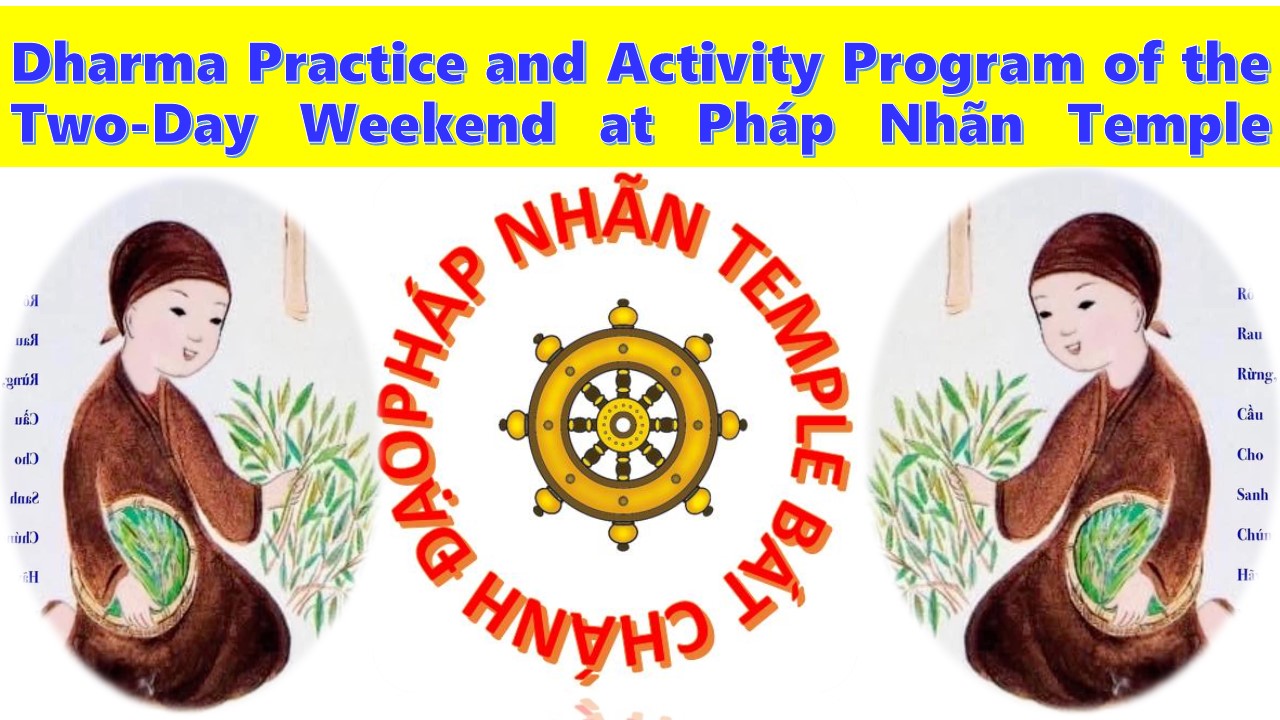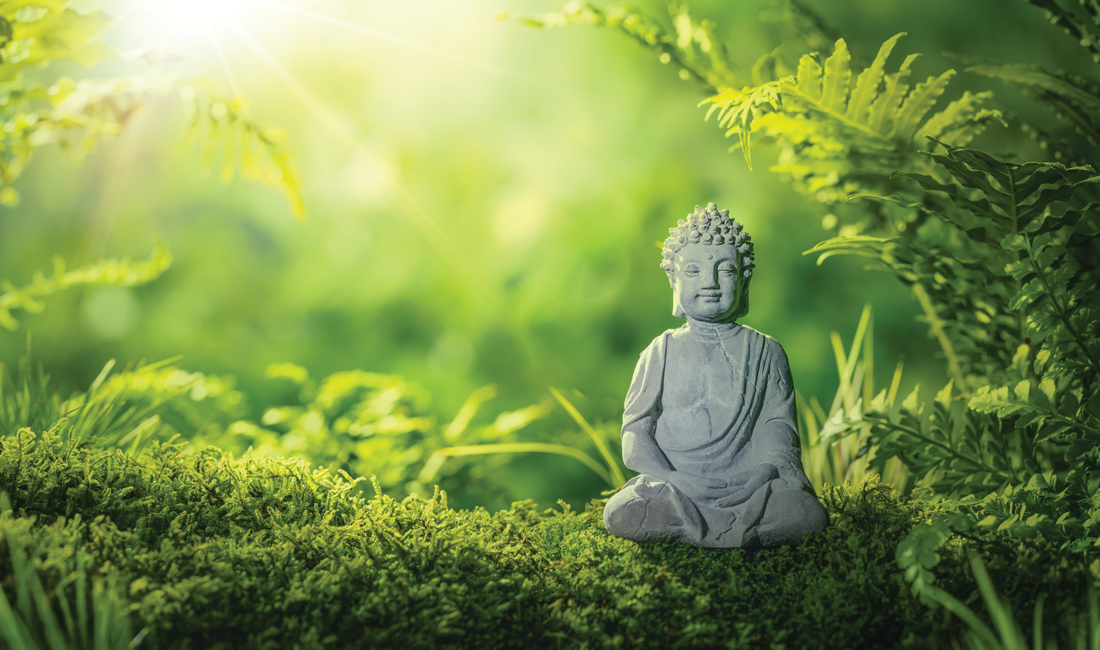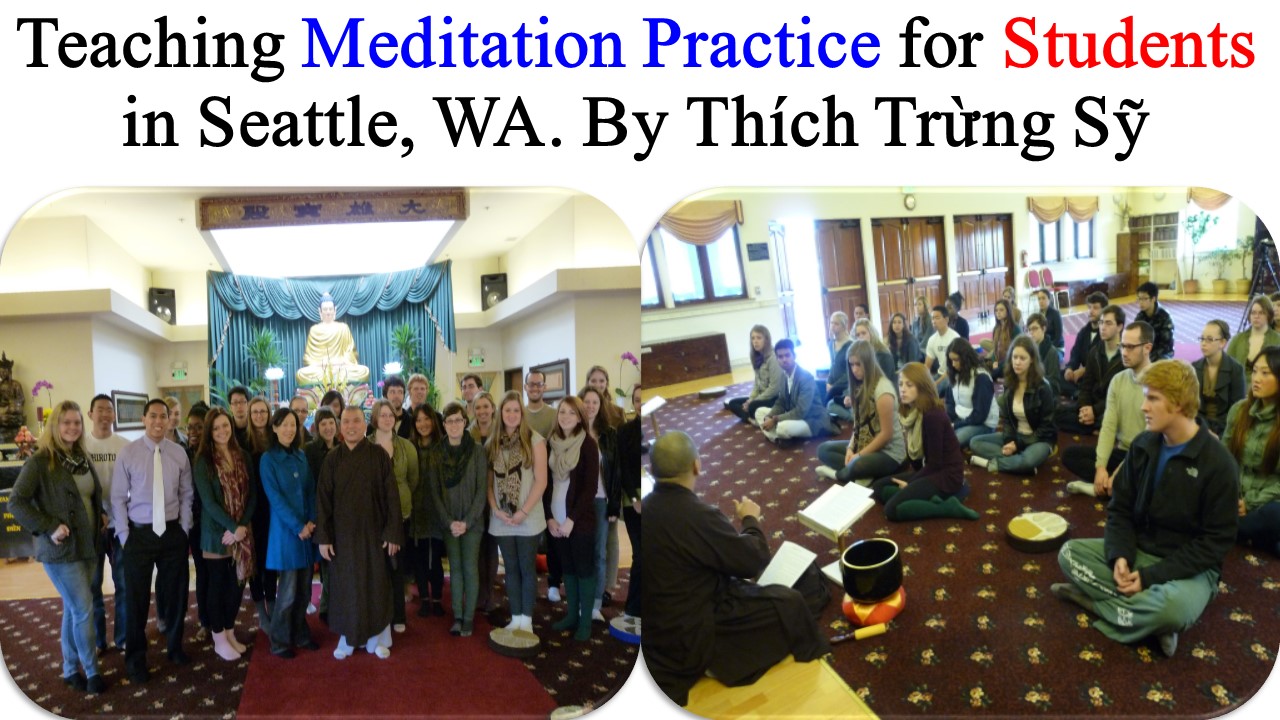
Please see the following readings and pictures happily.
Bill Hirsch, a Buddhist Professor of Seattle University in Washington State, had a good opportunity to invite Venerable Thích Trừng Sỹ to go to Pigott Auditorium of Seattle University,[1] to share the Dharma talk with the topic “Meditation Practice” for Professors and Students at this University. Also in this topic, Professor, Dr. Sharon Suh,[2] Chair of Religious Studies and Theology of the University, led about her 30 students to Cổ Lâm Buddhist Temple in Seattle City in order to learn and practice meditation instructed[3] by Venerable Thích Trừng Sỹ about over one hour under the permission of the Most Venerable Thích Nguyên An.
Dear Professors and Students,
Today, I am happy to meet Professors and students present, instruct, and share the Dharma talk with the topic “Meditation Practice” for you all. As you know meditation is the spiritual food that is so essential to our daily lives. Meditation in the Pāli language is Jhāna. In the Sanskrit language, it is Dhyāna. In the Japanese language, it is Zen. In the Chinese language, it is Chán. In the Vietnamese language, it is Thiền.
Meditation means quietness, stillness, calmness, tranquility, mindfulness, awakening, concentration, contemplation, and single-pointed mind. It is a very vivid, peaceful, and helpful practice subject for one’s body and mind. Meditation has the ability to lead us right mindfulness and awareness, and help us be aware of what is happening right here and right now in the present life, such as blue sky, white cloud, birdsong, the sound of pine, flowering, murmuring stream, etc. Meditation practice has the ability to help us stop, recognize, and transform defilements of unhappiness and suffering into peacefulness and happiness.
There are two kinds of meditation in Buddhism: Samatha Meditation and Vipassāna Meditation. “Samatha” in Samatha Meditation means calm, concentration, single-pointed mind, or stopping. Vipassāna in Vipassāna Meditation means insight, clearly seeing, lucidly understanding, contemplation, or deeply looking.
The word “Samatha” is almost interchangeable with the word “Samādhi,” and it originates from the same root as Sam in Samādhi. Samatha means stopping, tranquility and calm. Stopping is a method of very important practice in Samatha Meditation.
When we are sitting meditation, we hear a noise happening around us. We are very clearly aware of that noise we stop and turn back our in-breath and out-breath mindfully and consciously. Breathing in, we know we are breathing in. Breathing out, we know we are breathing out. Breathing in, we know the noise is in our mind and we are noticing it. Breathing out, the noise in our mind is slowly calming and not any longer. Practicing like this a few times by following in-breath and out-breath mindfully and consciously, the sound we hear disappears gradually. That is Samatha Meditation.
Samatha Meditation means stopping the wandering mind and focusing it on the conscious breath. As you know our minds, which are like monkeys and horses, pass from this branch to another, and run from this place to another. Sometimes we sit here, but our minds think aimlessly about New York, India, Australia, Vietnam, etc. To put our wandering minds into conscious breath by meditation practice, gradually we lead them to concentration and single-pointed mind. Do not worry when our minds travel far away. Gently put them on the conscious breath by following the in-breath and out-breath deeply, long, slowly, and relaxedly.
As you know whirring is the nature of the mind; moving is the nature of the mind; stillness is the nature of the mind; concentration is the nature of the mind; relaxation is the nature of the mind, etc. The practice of Samatha Meditation is the process so that practitioners can purify and transform the minds of wandering and whirring into those of tranquility, concentration, and relaxation.
The word Vipassāna is derived from two roots: “Vi” and “Passāna.” “Vi” is a prefix that means to divide or to separate. “Vi” means to observe oneself in the method of contemplative meditation. “Passāna” means to see or to perceive. Thus, Vipassāna means to look deeply at all things and know they are impermanence, dependent origination, and no self. Vipassāna is the process of cultivating and purifying the body and the mind, and it leads practitioners to an authentically happy and peaceful life right here and right now in the present life.
Vipassāna Meditation means to contemplate our breath clearly and lucidly.
Breathing in, I know I am breathing in,
Breathing out, I know I am breathing out
In and out. (Bell)
Breathing in, I know I am alive and sitting here.
Breathing out, I know I am still alive and sitting here practicing meditation together with Dharma Sisters and Brothers today.
In and out. (Bell)
Breathing in deeply, I know I am breathing in deeply.
Breathing out slowly, I know I am breathing out slowly.
In and out. (Bell)
Calming bodily action, I am breathing in,
Calming bodily action, I am breathing out.
In and out. (Bell)
Calming mental action, I am breathing in,
Calming mental action, I am breathing out.
In and out. (Bell)
Calming verbal action, I am breathing in,
Calming verbal action, I am breathing out.
In and out. (Bell)
Feeling the whole body, I am breathing in,
Feeling the whole body, I am breathing out.
In and out. (Bell)
Feeling the whole mind, I am breathing in,
Feeling the whole mind, I am breathing out.
In and out. (Bell)
Be aware of the whole body, I am breathing in,
Be aware of the whole body, I am breathing out.
In and out. (Bell)
Be aware of the whole mind, I am breathing in,
Be aware of the whole mind, I am breathing out.
In and out. (Bell)
Breathing in, I know I am practicing meditation for myself, for my parents, sisters, brothers, and for my children
Breathing out, I know I would like to invite my parents, sisters, brothers, and my children to practice meditation and learn the Dharma with me together today.
In and out. (Bell)
Breathing in, I know I am charging my spiritual battery
Breathing out, I know my spiritual battery gets fuller and fuller.
In and out. (Bell)
Breathing in, I know I am practicing the method of watering flowers
Breathing out, I know flowers in me get fresher and fresher.
In and out. (Bell)
Breathing in, I know, every day I forget to charge my spiritual battery, my spiritual battery will be weaker and weaker
Breathing out, I know, every day I forget to water flowers, flowers in me will be more and more withered.
In and out. (Bell)
Breathing in, I know every breath is life
Breathing out, I know every practice is calm and relaxed.
In and out. (Bell)
Breathing in, I know, every day my life is shorter and shorter
Breathing out, I know, every day my health is weaker and weaker.
In and out. (Bell)
Breathing in, I know I am making use of the rest of my life to practice the Buddhadharma more and more diligently
Breathing out, I know I am making use of the rest of my health to apply the Buddhadharma into my daily life to benefit myself and other people right here and right now in the present life.
In and out. (Bell)
Breathing in, I contemplate that all living things and living beings on earth are changing and impermanent
Breathing out, I contemplate they are arising and ceasing continuously, and never stopping.
In and out. (Bell)
Breathing in, I feel well and healthy
Breathing out, I feel calm and peaceful.
Well, healthy, calm, and peaceful.
In and out. (Bell, bell, bell)
With what I have just practiced above, I can summarize with mindfulness mind like this:
“In, out, deeply, slowly, peacefully, stably, calmly, and relaxedly.”
The process of practicing Vipassāna Meditation is the process of cultivating wisdom and that of reaping the flowers and fruits of peaceful joy and happiness right here and right now in the present life. When practicing Vipassāna Meditation, we do not think about the past, do not lose ourselves in the future, we only know to dwell stably in mindful breathing right in the present moments. Because the past has passed, the future has not yet come, only the present moments are the wonderful moments. We dwell stably in the present moments in order to follow our in-breath and out-breath mindfully and consciously. When we understand and practice so regularly, we can eliminate worries, sorrows, anger, and regrets effectively.
Thanks to practicing Vipassāna Meditation, we can see that everything is impermanent, namely, greed is impermanent, anger is impermanent, delusion is impermanent, suffering is impermanent, etc. if the greed, anger, delusion, etc., are permanent, we cannot change them, but in fact, they are impermanent and changing. As awakened people who cultivate well, we can recognize and transform them step by step; transform greed into non-greed – generosity; anger into non-anger – compassion; delusion into non-delusion – wisdom; sorrow into joy; suffering into happiness by practicing saying good words, thinking of good thoughts, and doing good actions to bring authentic peaceful joy and happiness for ourselves and for other people right in this lifetime.
Cultivating Vipassāna Meditation, with the interrelated look, we can contemplate and clearly see our parents in us, children in us, sisters and brothers in us, teachers and students in us, everyone in us, and us in every one. We see them very well in each of our cells. To apply meditation practice suitably, skillfully, and intelligently, we can invite them to practice meditation together with us in the present and precious moments. We know our happiness is their happiness, our peaceful joy is their peaceful joy, our freshness is their freshness, etc.
Practicing Vipassāna Meditation, we know our lives are always changing and impermanent; our lives will be shorter and shorter, and we live on this earth for a certain period of time, then gradually we all have to abandon this physical body and die, no one can exist on this earth forever, including the Buddha. However, being well aware of that, in order to prepare good things and baggage for life, we strive to make use of our remaining health and life to practice and manipulate the energies of love and understanding for ourselves and for other people right in this life.
Be aware that breathing in but without breathing out, we will pass through another life, once impermanence comes, we will calmly pass away gently, living is joyful, dying is peaceful. Therefore, we live deeply and freely in every second, every minute, every hour, and every day. Every breath is life, every practice is calm, every moment is life, every moment is relaxing, when we understand and practice so, we feel peaceful and happy in the present.
Thus, Samatha or Stopping Meditation and Vipassāna or Insight Meditation, presented above are for readers and learners to easily learn, understand, remember, and easily practice. According to the interrelated look, in Samatha Meditation there is Vipassāna Meditation; and in Vipassāna Meditation there is Samatha Meditation. Samatha Meditation and Vipassāna Meditation always go together. However, in the process of practice, we can practice it one by one as long as we bring our minds and bodies to the right mindfulness and awareness, stability and calmness, peaceful joy and happiness right in the present life.
Practicing meditation regularly every day, we can treat and relieve pains and stresses, or tensions in our bodies and minds, and we can nurture and develop the energies of compassion and wisdom, joy and happiness for ourselves and others right in the present life. When spending proper time applying meditation practice to the morning, afternoon, or evening, we have so much more spiritual energy, peace, and stability within us.
From practicing meditation smoothly, what we say, what we think, and what we do can bring the flowers and fruits of authentic joy and happiness to ourselves and to other people right in this lifetime. Applying meditation practice every day means we practice watering flowers every day. Every day we water flowers, then every day the flowers in us will become fresh and beautiful, and vice versa, every day we forgot to water flowers, then every day the flowers in us will dry and wither step by step. Meditation practice is for us to water flowers every day. Meditation practice is for us to create and charge more spiritual energies every day. When we understand and practice so, peaceful joy and happiness have the ability to instill and cool our bodies and minds.
Likewise, we have the spiritual batteries that we carry with us for life. Our spiritual batteries have the ability to store the energies of love and understanding, joy, and happiness if we know how to recharge our spiritual powers by applying meditation practice in our daily lives. Every time of practicing meditation is every time of watering flowers. Every time of practicing meditation is every time of recharging more our spiritual powers. Every time of practicing meditation is every time of arousing and nurturing the seeds of enlightenment in us to germinate and rise up beautifully.
In one day, two days, or three days; in one week, two weeks, or three weeks, if we forgot to water the flowers, then the flowers in us would be gradually withered and dried; if we forgot to recharge our spiritual batteries, the energy of love in us would be weaker and weaker; and if we forgot to practice meditation, the peaceful energy in us could also be weaker and weaker. At that time, we do not have enough energy of spirituality, love, peaceful joy, and happiness to share with other people. The process of cultivation is the process of accumulating and recharging more energies of spirituality, joy, and happiness for oneself and for others right in this lifetime.
In daily life, although busy doing many things, let us not forget to water flowers, recharge our spiritual energy, and practice meditation. We are aware that daily watering flowers are necessary; daily recharging spiritual energy is important, and daily applying meditation practice is relaxing. When we understand and practice so, the flowers in us will become gradually fresh and beautiful, spiritual batteries in us will become fuller and fuller, and spiritual energy in us will be more abundant. Thanks to applying meditation practice fluently, we can reap the flowers and fruits of compassion and wisdom, joy and happiness right here and right now in the present life. From applying meditation practice to everyday life, we have the ability to share and dedicate the fragrant flowers and sweet fruits, and peaceful energy to all living beings and living things on this earth.
“Virtuous blossoms instill in the mind,
Flowers of compassion spread all mountains and rivers.
Each of us is every practitioner
donating life the fragrant flowers and delicious fruits.”
By Thích Trừng Sỹ
Thus, meditation is an indispensable spiritual food in our everyday life. We can apply meditation to anywhere and anytime, such as at school, at home, in a quiet place, or in an office, even when driving and waiting for the red light, when doing homework, composing, writing posts, when lining up to buy tickets, when shopping, etc. Breathing in and breathing out, we know we are dwelling mindfully in the present moments. With conscious breathing, we breathe in; with conscious breathing, we breathe out. With mindful breathing, we breathe in; with mindful breathing, we breathe out. Breathing in, we know we are breathing in. Breathing out, we know we are breathing out. We practice like this regularly every day, the energy of loving-kindness, compassion, joy, and happiness in us grows and develops.
We know that our lives are available in breaths;
Breaths are available in right mindfulness;
Right mindfulness is available in peaceful joy and happiness;
Peaceful joy and happiness are available in our bodies and minds.
Cultivating is the process of recognizing, purifying, and transforming
wrong into right,
sorrow into joy,
defilement into bodhi,
suffering into peacefulness and happiness step by step.
To cultivate is to achieve peaceful joy and happiness for oneself and for others
right here and right now in the present life.
Indeed, the more we apply meditation practice every hour, the more peaceful we feel with it every hour. The more we apply meditation practice every day, the happier we feel with it every day, and the more we apply meditation practice every week, the more joyful and calm we feel with it every week. Peaceful joy is in meditation practice, happiness is in meditation practice, and freedom is in meditation practice. From practicing meditation fluently, joy and happiness have the ability to permeate and cool our bodies and minds.
Before finishing my Dharma talk about meditation practice, I would like to invite you to sing a meditation song entitled “I am free” happily.
“Breathing in, breathing out,
Breathing in, breathing out,
I am blooming as a flower,
I am fresh as the dew,
I am solid as a mountain,
I am firm as the earth.
I am free. I am free.
Breathing in, breathing out,
Breathing in, breathing out,
I am water
Reflecting
what is real, what is true
And I feel
There is space
Deep inside of me
I am free, I am free, I am free.”[4]
(Plumvillage song)
After finishing singing the song, I would like to invite you to practice meditation together for about 15 minutes. Now I would like to guide you basically and simply how to sit meditation, how to follow in-breaths, out-breaths, how to train your bodies and minds, and how to go walking meditation.
At home or here, you can sit upright on a chair, on a couch, in a bed, or on a cushion. In the lotus position, you can sit cross-legged or half cross-legged. You put right hands on left hands or put left hands on right hands. You put right feet on left thighs or left feet on right thighs. Your thumbs touch each other. Your backs are straight. Your eyes close. Whenever you feel sleepy, you can open your eyes a little. You sit meditation in comfortable and stable positions.
Breathing in, you know your bellies are inflating. Breathing out, you know your bellies are deflating. You keep following your in-breath and out-breath regularly from beginning to end. While practicing meditation, if you hear a sound of a car, a sound of a motorcycle, a sound of a barking dog, etc., you recognize that sound in your mind for a few seconds, and then, you come back to your in-breaths and out-breaths mindfully and consciously.
When you are meditating, there is the fragrance of a flower, the scent of fruit, or the smell of something else happening to your noses. You can recognize the aroma for a few seconds, return to the breath, and keep following your in-breath and out-breath mindfully and consciously, or when you are sitting meditation, you feel itchy. You slowly bring your hands to the itchy spot and scratch it softly. When you finished scratching, you slowly bring and place your hands back into your palms. At that time, the pleasant feelings in your bodies and minds arise, you recognize them and continue following your in-breaths and out-breaths mindfully. When sitting meditation, your legs become numb and uncomfortable, you recognize the feelings of numbness and discomfort for about a few seconds and minutes. You gently and mindfully change your sitting postures, and then you continue to maintain the pleasant feelings in you.
When you are sitting meditation, you want to stand up to go for walking meditation, first, open your eyes and rub your hands together, put your hands on your faces, and gently massage your faces and heads two or three times, and then, you lift and straighten your legs, move your bodies slowly, and start standing up in mindfulness. You walk step by step and know that every step is stable, every step is free, every step is life, and every step is peaceful and joyful.
When applying such a regular meditation every hour, every day, every week, every month, and every year, you can enjoy the Dharma learning, the Dharma practice, the Dharma joy, the Dharma happiness right now and right here in the present life. Indeed, when you understand and practice like that, you will be fresh flowers to beautify this world.
I wish you all success in meditation practice.
Meditation applications are everywhere
Together, the effort is usually peaceful.
By Thích Trừng Sỹ
Giảng Dạy Thiền Tập cho Sinh Viên ở Thành Phố Seattle, Tiểu Bang Washington
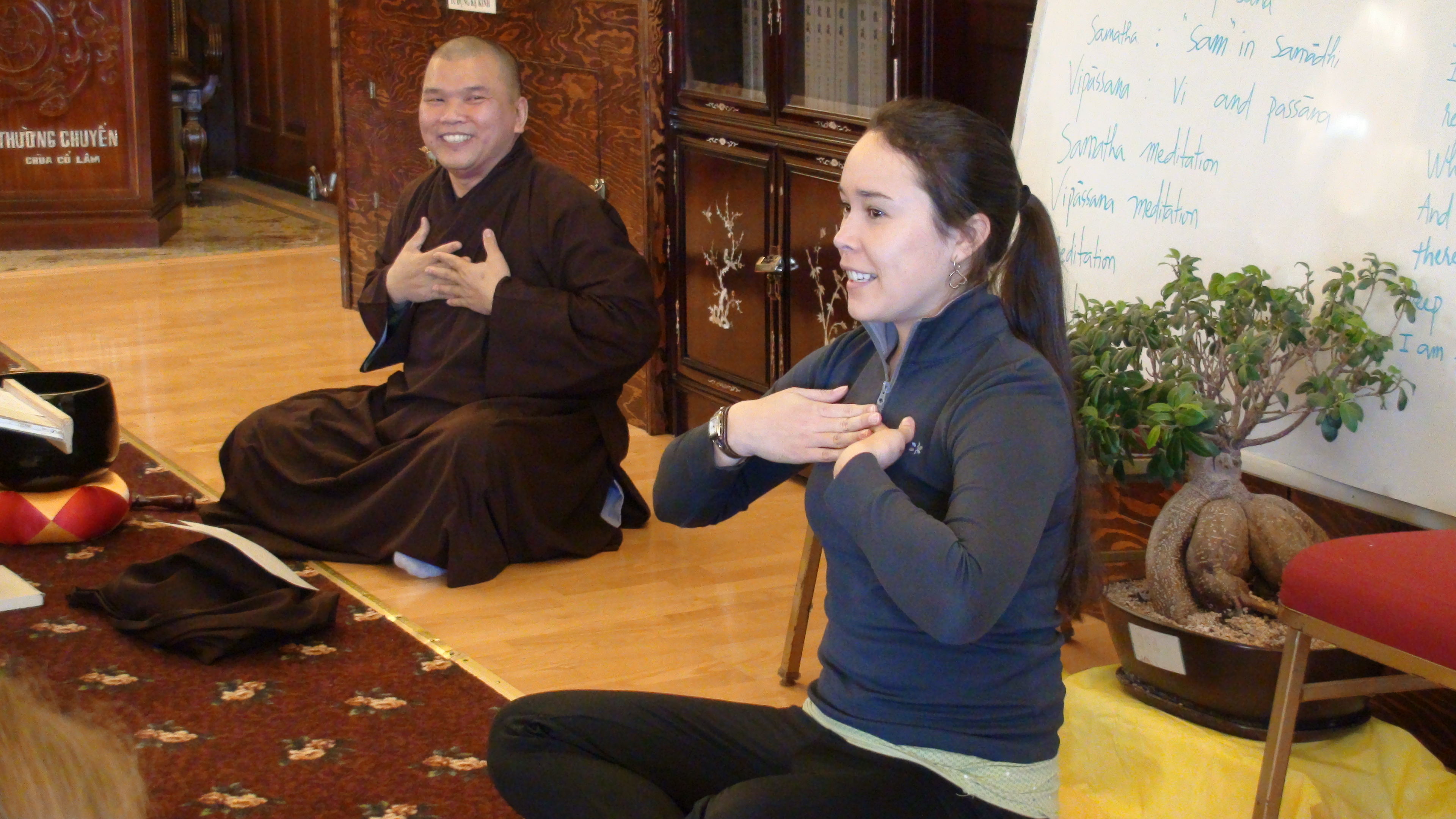
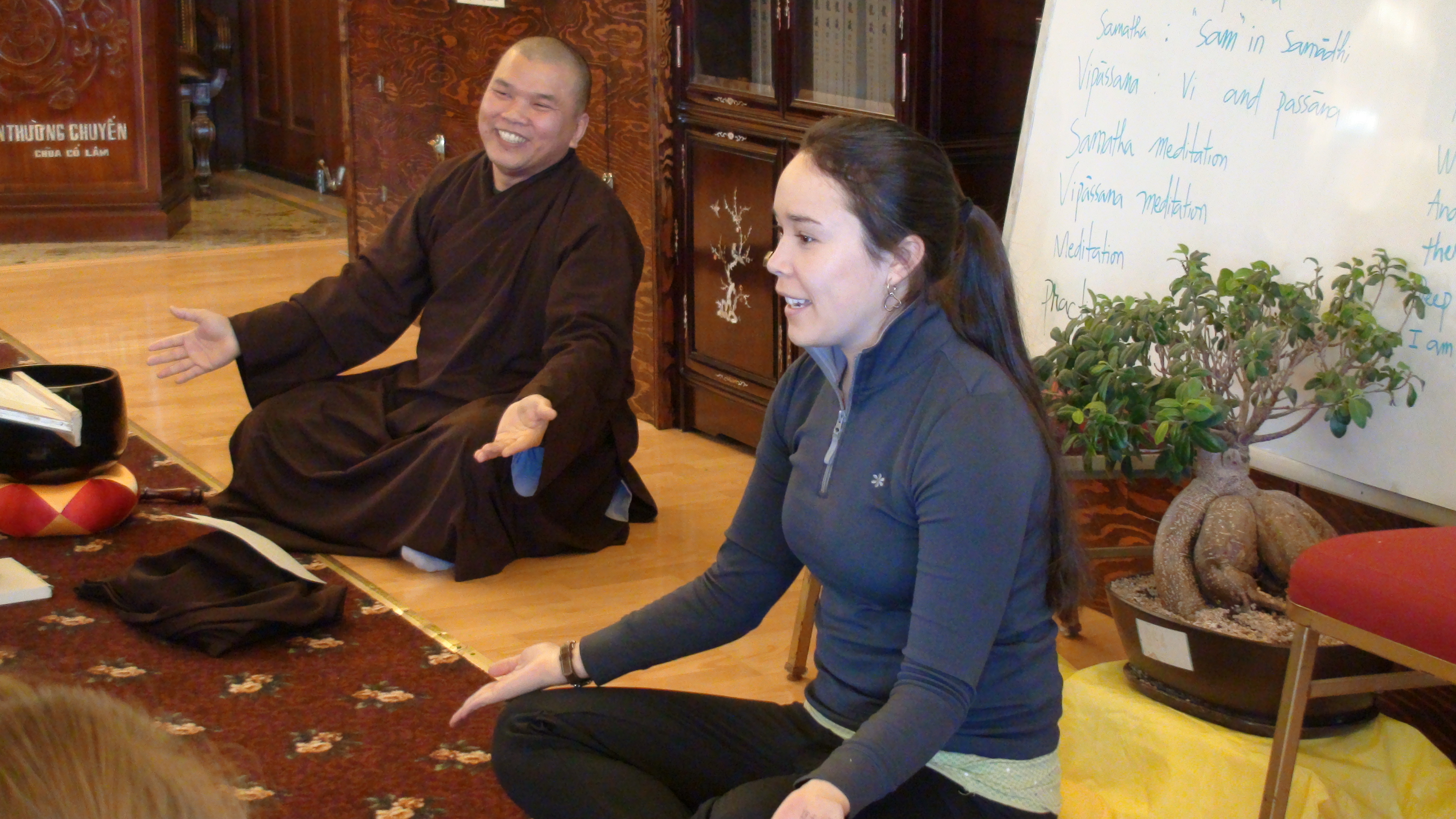

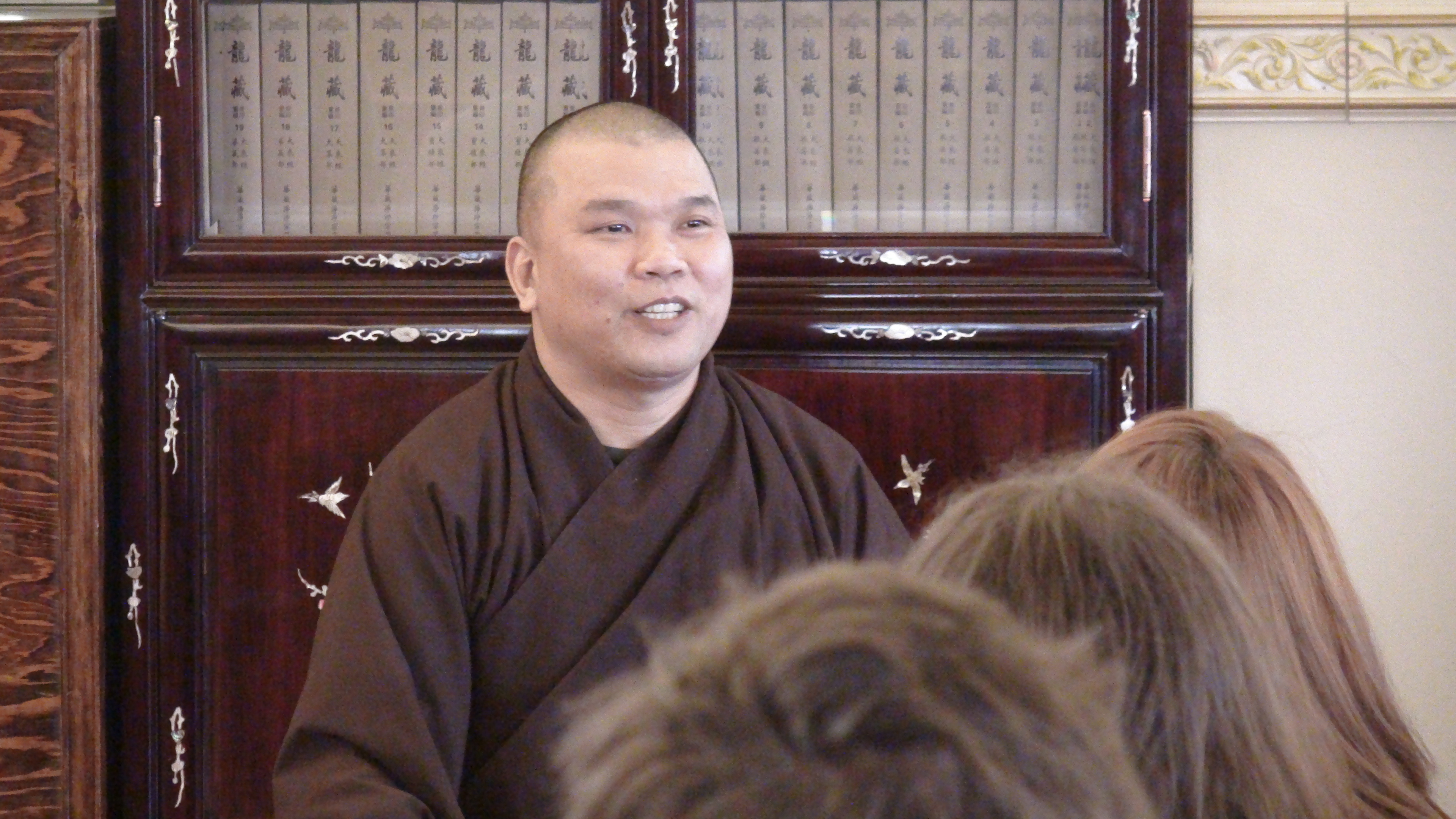
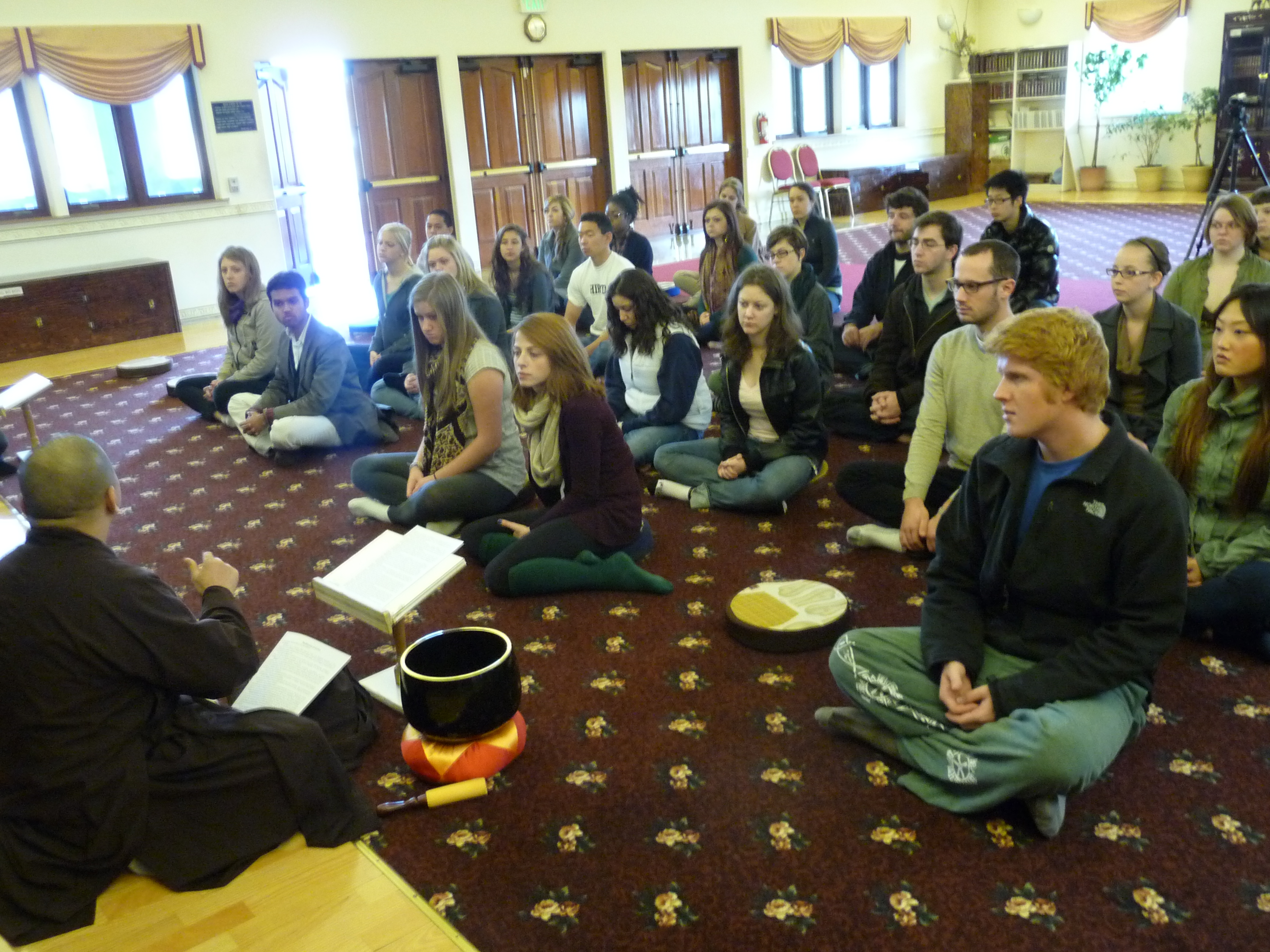
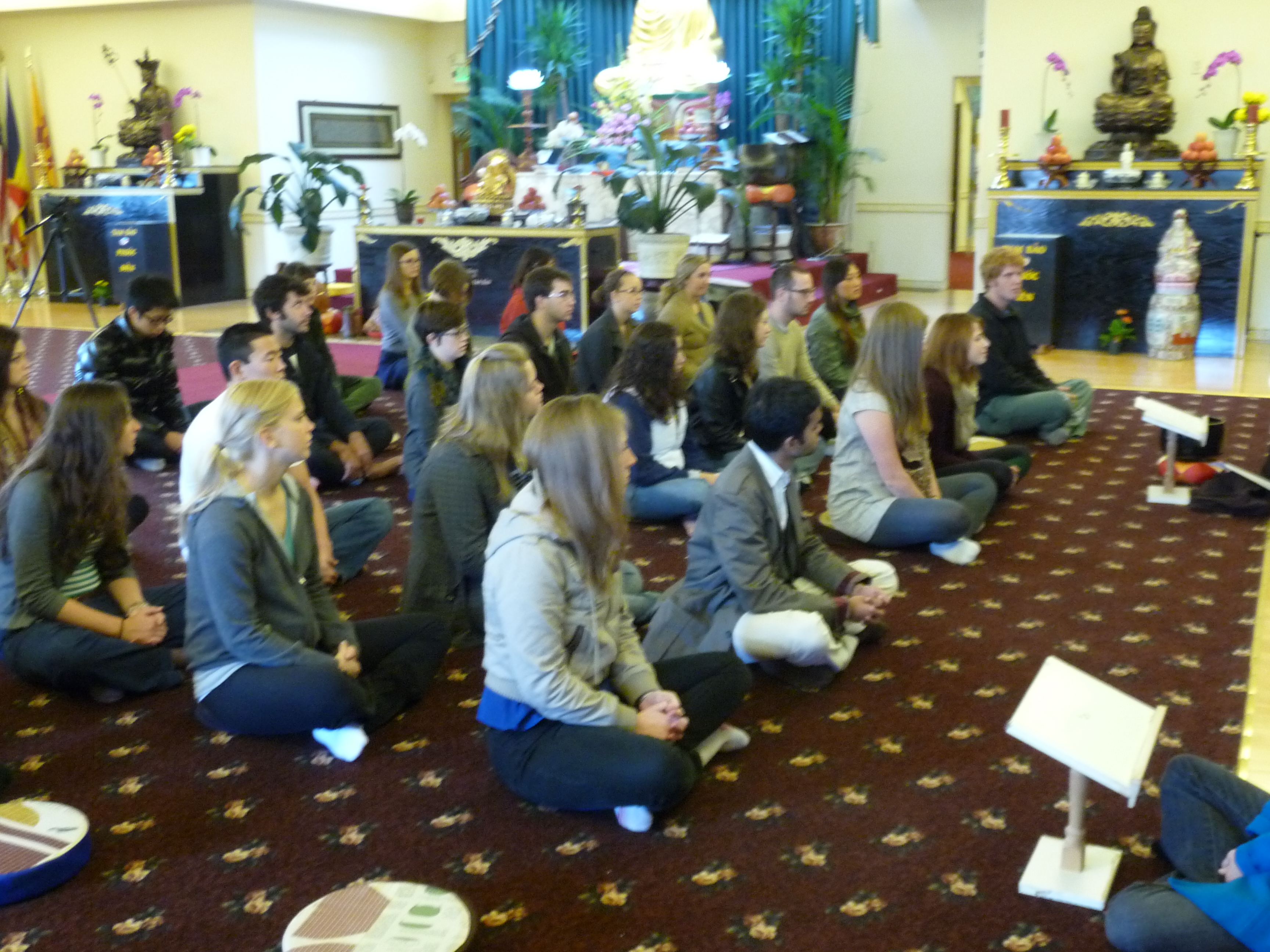
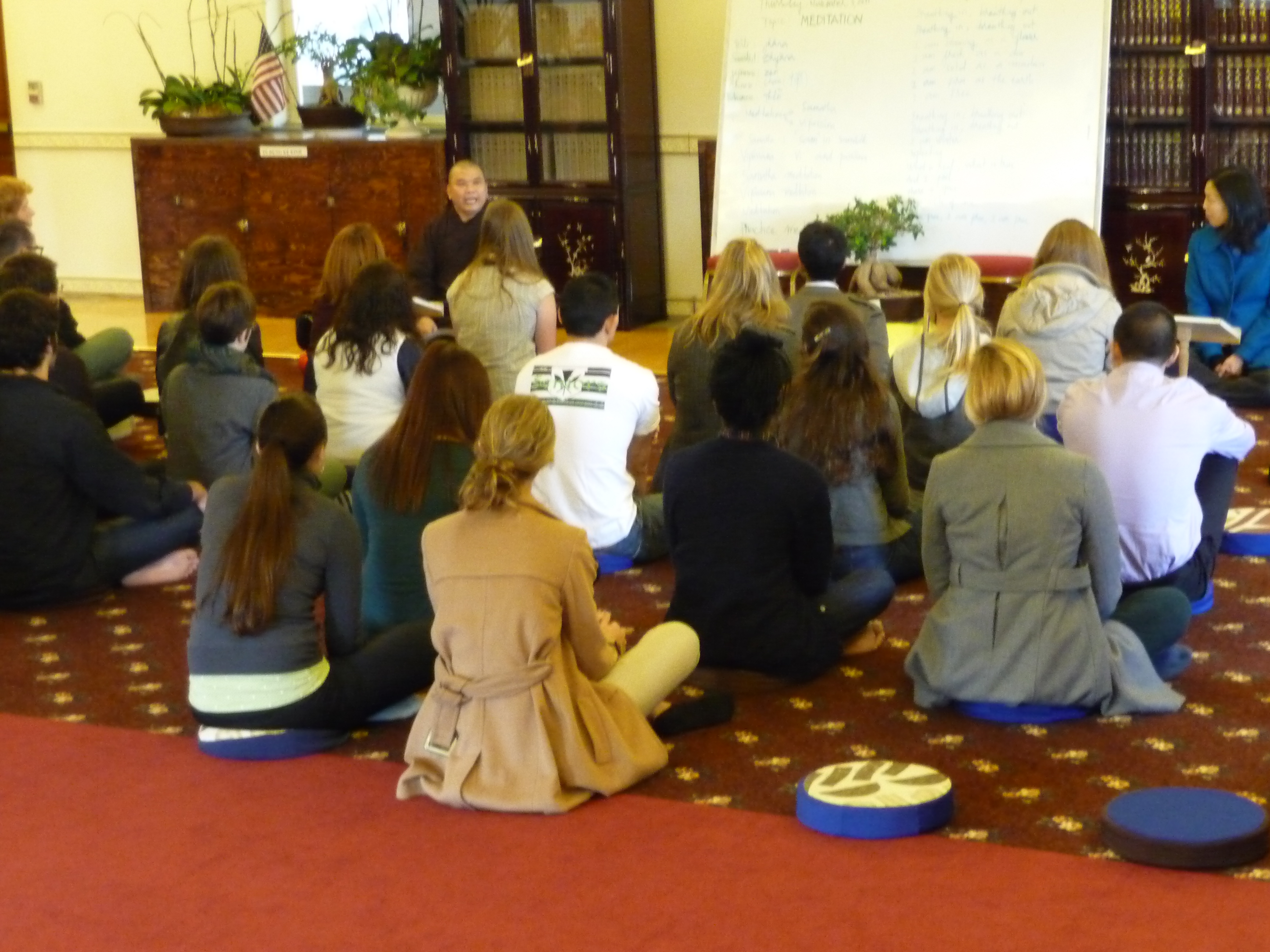
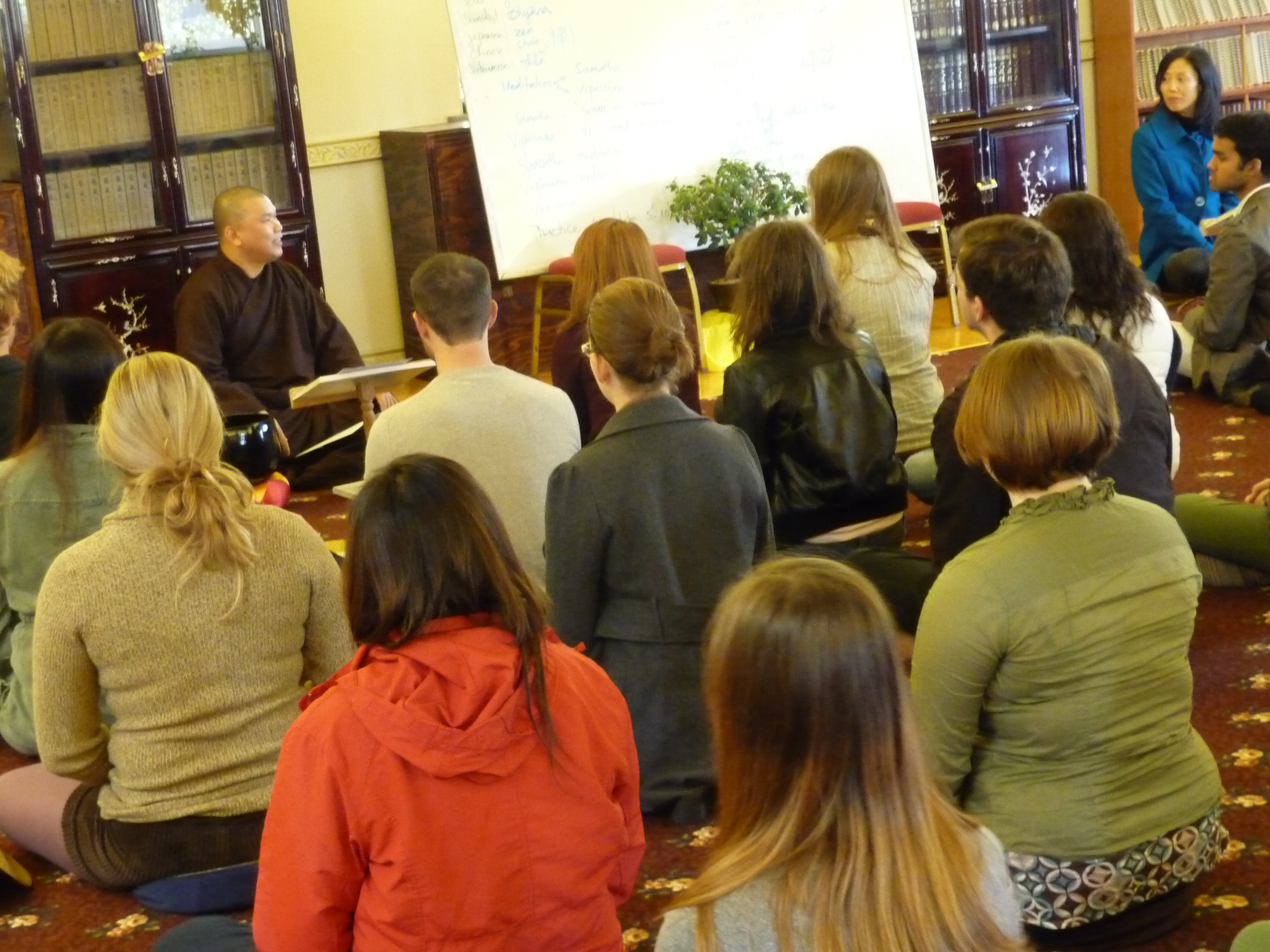
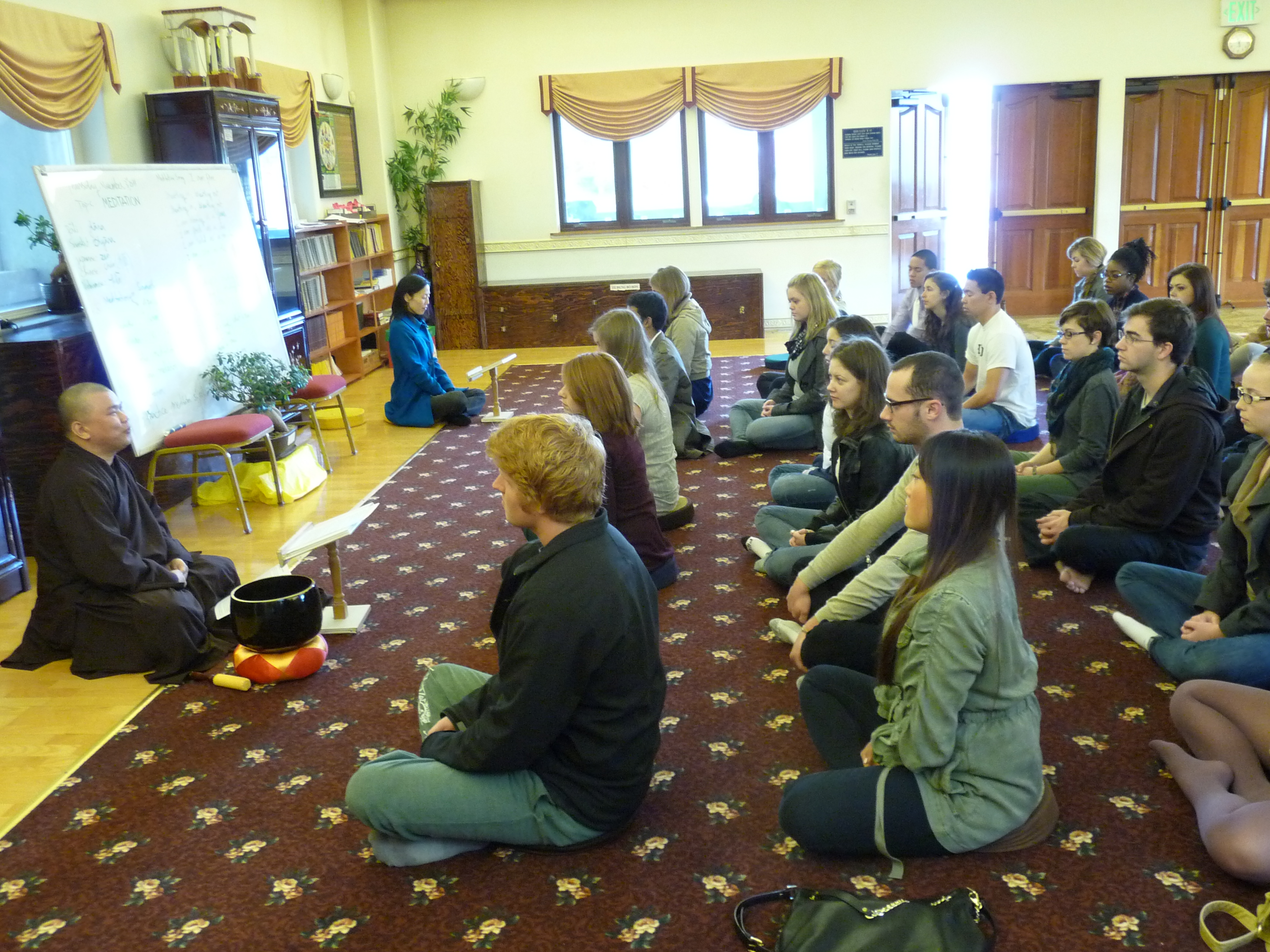
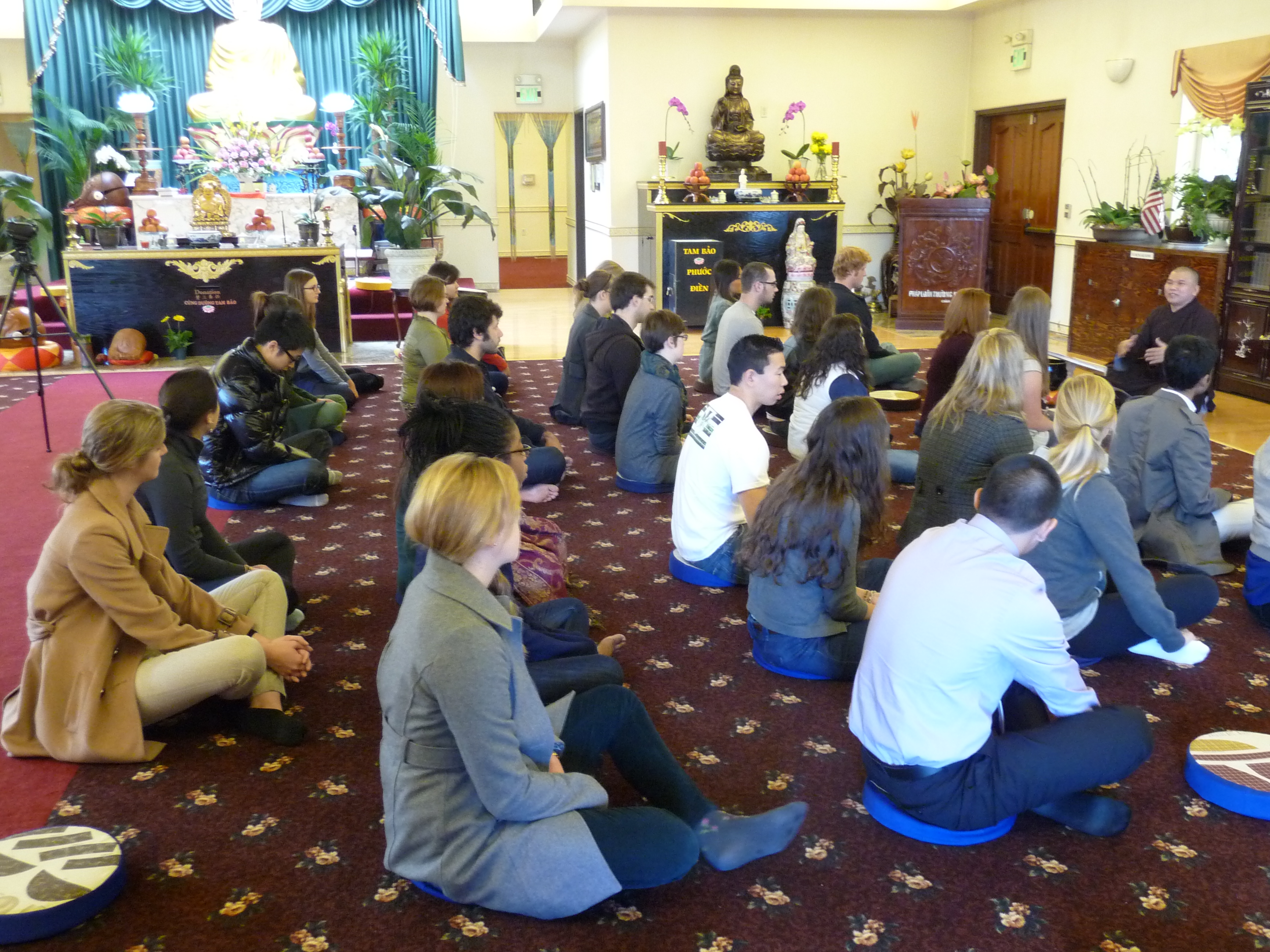
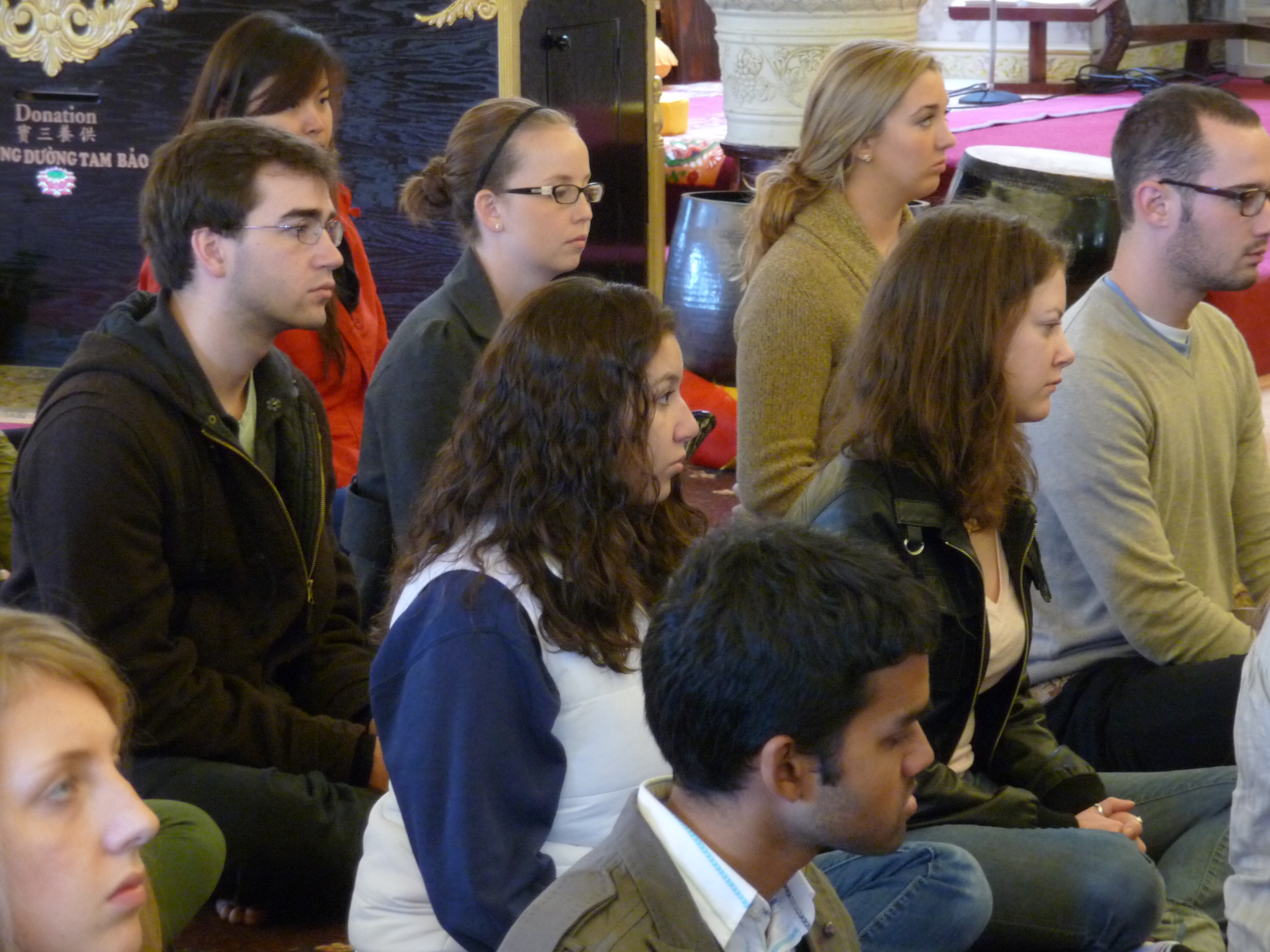
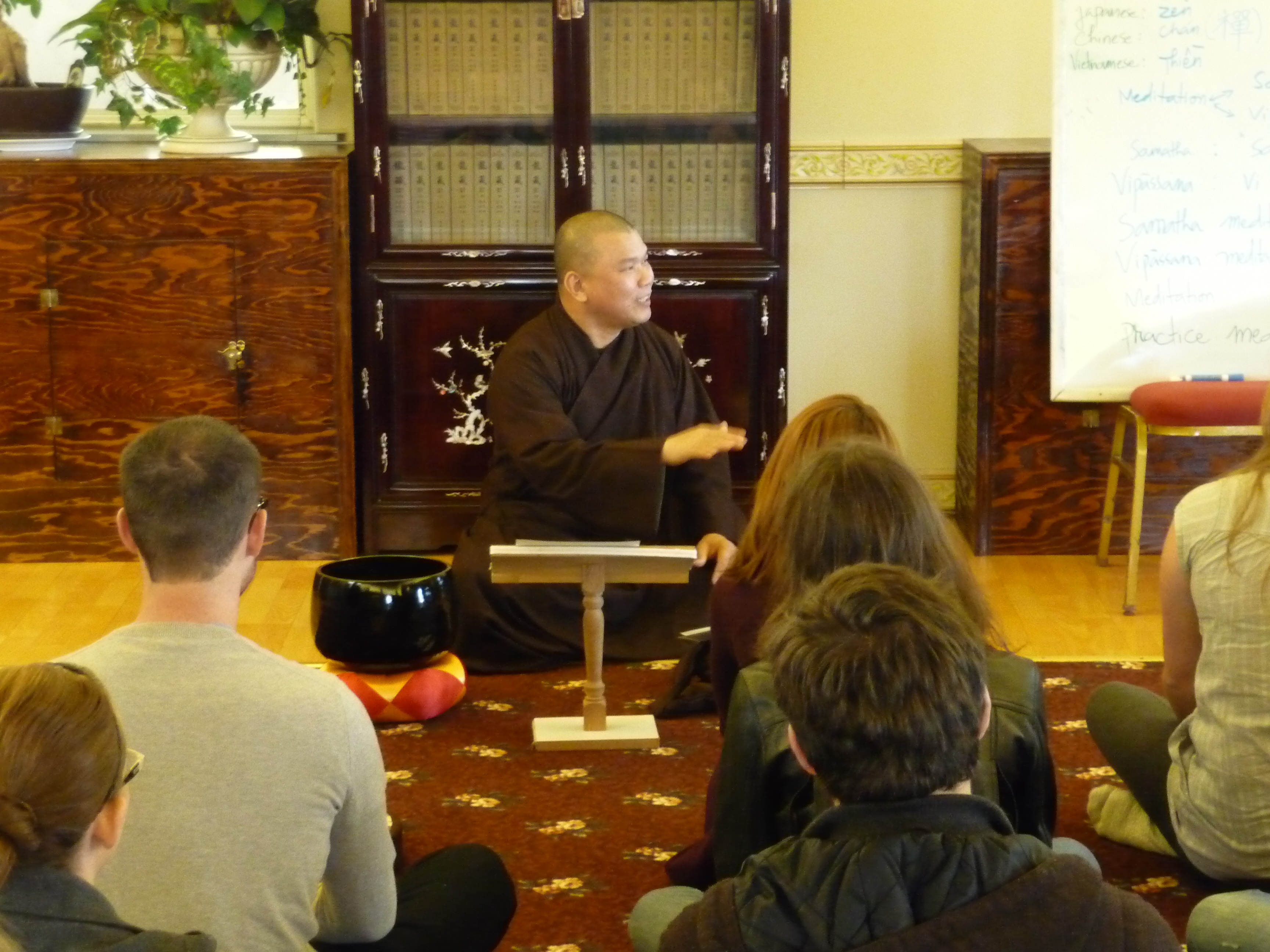
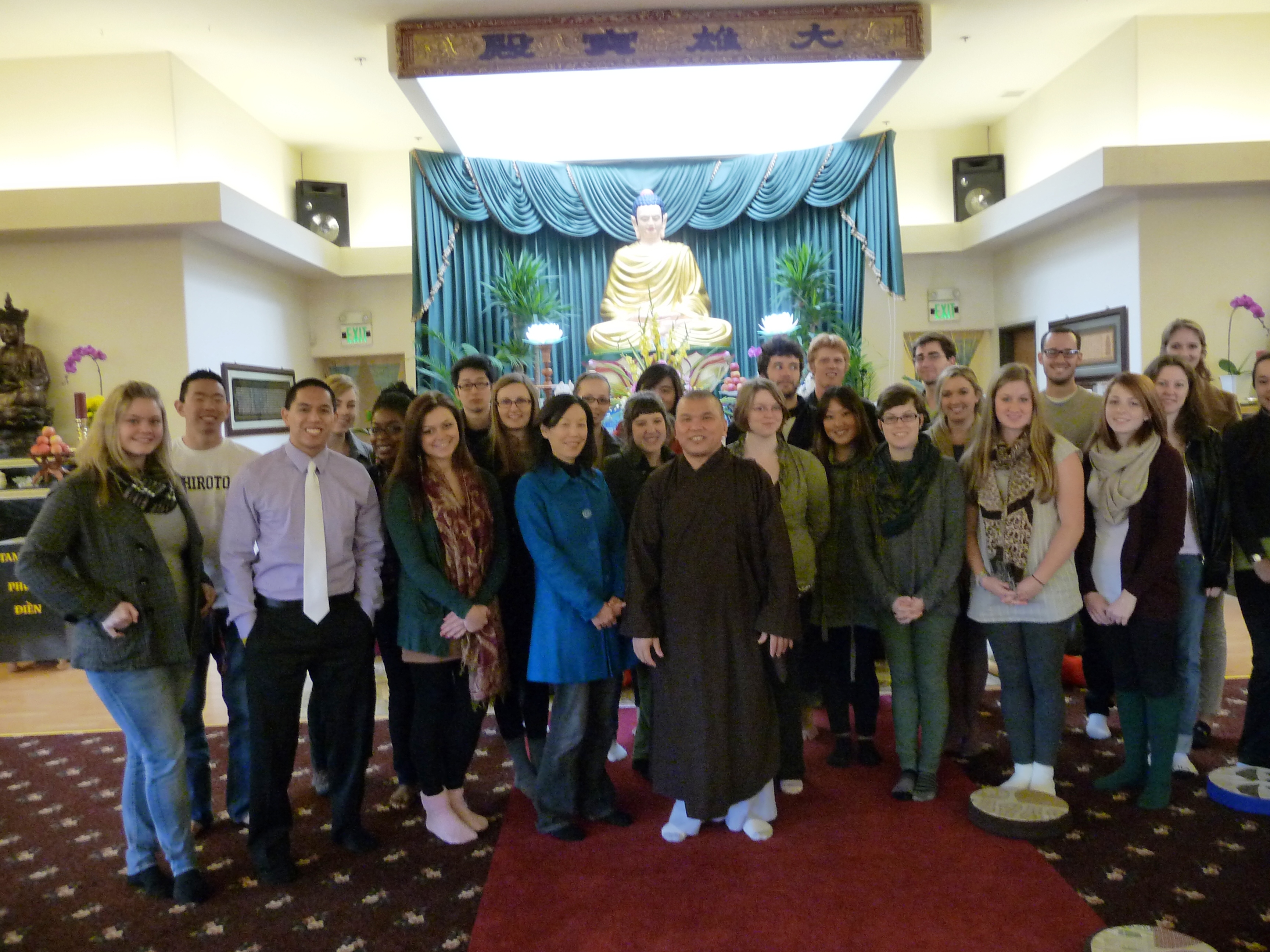
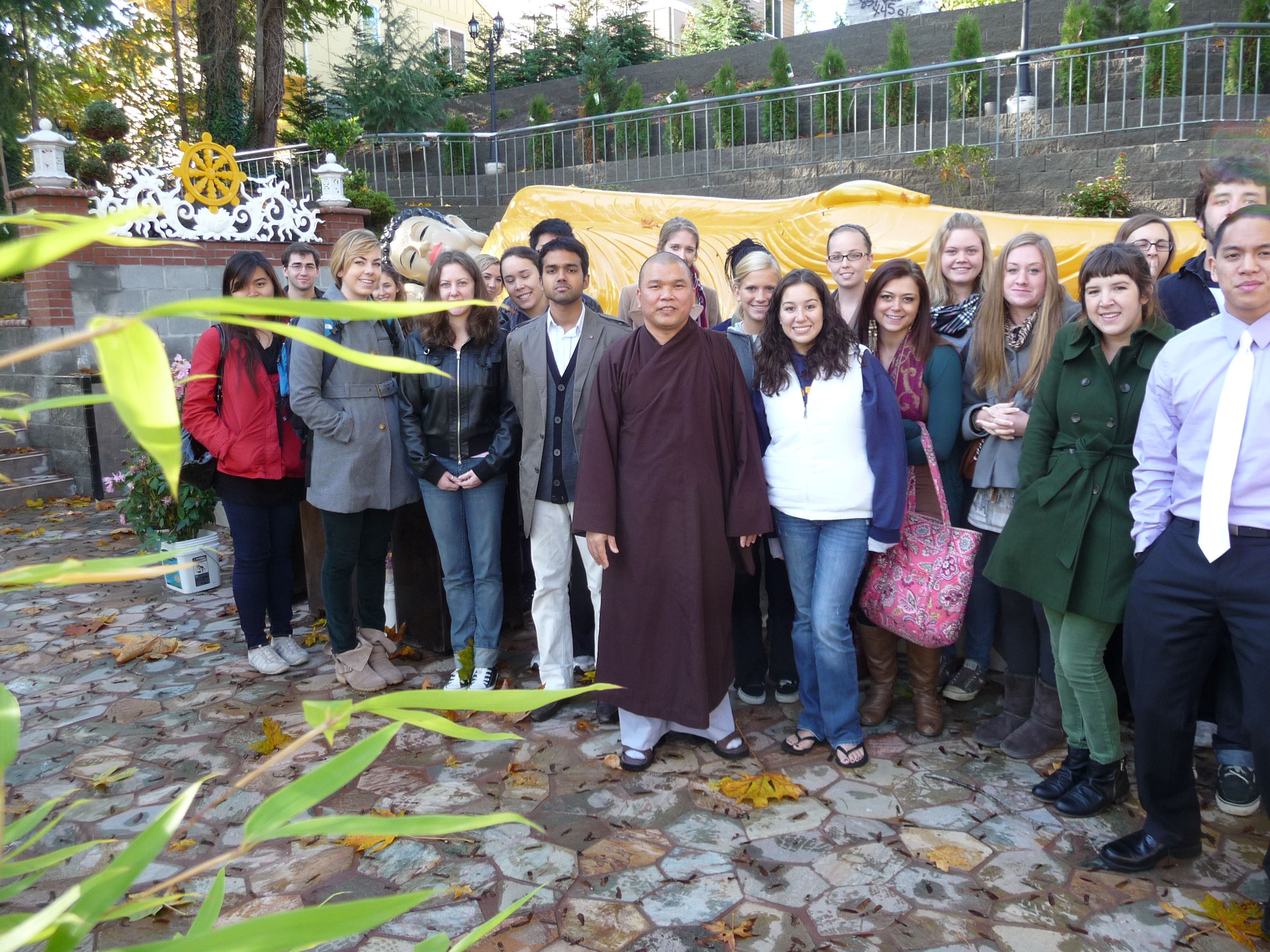






[1] Seattle University in Washington State is a Jesuit Roman Catholic University. At present, Buddhist Studies are being officially taught at this University. Buddhist Studies have become part of the curriculum of Universities in America as well as in many other countries all over the world.
[2] Prof. Sharon Suh, graduated from Harvard University with a Doctor’s Degree in Religious Studies and Theology. At present, the Professor is in charge of a Chair of Religious Studies and Theology at Seattle University in Washington State.
[3] http://www.youtube.com/user/Hoatraituhoc#p/u/8/l2e9FSzZQFU
http://www.youtube.com/watch?v=dDvLs2qJy18
[4]http://www.youtube.com/watch?v=jshH6GQbSbw&feature=related


